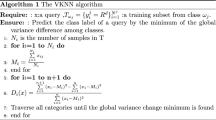Abstract
The renowned k-nearest neighbor decision rule is widely used for classification tasks, where the label of any new sample is estimated based on a similarity criterion defined by an appropriate distance function. It has also been used successfully for regression problems where the purpose is to predict a continuous numeric label. However, some alternative neighborhood definitions, such as the surrounding neighborhood, have considered that the neighbors should fulfill not only the proximity property, but also a spatial location criterion. In this paper, we explore the use of the k-nearest centroid neighbor rule, which is based on the concept of surrounding neighborhood, for regression problems. Two support vector regression models were executed as reference. Experimentation over a wide collection of real-world data sets and using fifteen odd different values of k demonstrates that the regression algorithm based on the surrounding neighborhood significantly outperforms the traditional k-nearest neighborhood method and also a support vector regression model with a RBF kernel.





Similar content being viewed by others
References
Alcalá-Fdez J, Fernández A, Luengo J, Derrac J, García S, Sánchez L, Herrera F (2011) KEEL data-mining software tool: data set repository, integration of algorithms and experimental analysis framework. J Mult-Valued Log Soft Comput 17:255–287
Biau G, Devroye L, Dujimovič V, Krzyzak A (2012) An affine invariant -nearest neighbor regression estimate. J Multivar Anal 112:24–34
Buza K, Nanopoulos A, Nagy G (2015) Nearest neighbor regression in the presence of bad hubs. Knowl-Based Syst 86:250–260
Caruana R, Niculescu-Mizil A (2004) Data mining in metric space: an empirical analysis of supervised learning performance criteria. In: 10th ACM SIGKDD international conference on knowledge discovery and data mining. New York, pp 69–78
Chaudhuri B (1996) A new definition of neighborhood of a point in multi-dimensional space. Pattern Recognit Lett 17(1):11–17
Cheng CB, Lee E (1999) Nonparametric fuzzy regression \(k\)-nn and kernel smoothing techniques. Comput Math Appl 38(3–4):239–251
Dasarathy B (1990) Nearest neighbor (NN) norms: NN pattern classification techniques. IEEE Computer Society Press, Los Alomitos
Dell’Acqua P, Belloti F, Berta R, Gloria AD (2015) Time-aware multivariate nearest neighbor regression methods for traffic flow prediction. IEEE Trans Intell Transp Syst 16(6):3393–3402
Demšar J (2006) Statistical comparisons of classifiers over multiple data sets. J Mach Learn Res 7:1–30
Eronen AJ, Klapuri AP (2010) Music tempo estimation with \(k\)-nn regression. IEEE Trans Audio Speech Lang Process 18(1):50–57
García S, Fernández A, Luengo J, Herrera F (2010) Advanced nonparametric tests for multiple comparisons in the design of experiments in computational intelligence and data mining: experimental analysis of power. Inf Sci 130:2044–2064
García V, Sánchez JS, Martín-Félez R, Mollineda RA (2012) Surrounding neighborhood-based SMOTE for learning from imbalanced data sets. Prog Artif Intell 1(4):347–362
Guyader A, Hengartner N (2013) On the mutual nearest neighbors estimate in regression. J Mach Learn Res 14:2361–2376
Hu C, Jain G, Zhang P, Schmidt C, Gomadam P, Gorka T (2014) Data-driven method based on particle swarm optimization and k-nearest neighbor regression for estimating capacity of lithium-ion battery. Appl Energy 129:49–55
Lee SY, Kang P, Cho S (2014) Probabilistic local reconstruction for \(k\)-nn regression and its application to virtual metrology in semiconductor manufacturing. Neurocomputing 131:427–439
Leon F, Popescu E (2017) Using large margin nearest neighbor regression algorithm to predict student grades based on social media traces. In: International conference in methodologies and intelligent systems for technology enhanced learning. Porto, Portugal, pp 12–19
Mack YP (1981) Local properties of \(k\)-nn regression estimates. SIAM J Algebr Discrete Methods 2(3):311–323
Ounpraseuth S, Lensing SY, Spencer HJ, Kodell RL (2012) Estimating misclassification error: a closer look at cross-validation based methods. BMC Res Notes 5(656):1–12
Sánchez JS, Marqués AI (2002) Enhanced neighbourhood specifications for pattern classification. In: Pattern recognition and string matching, pp 673–702
Sánchez JS, Pla F, Ferri FJ (1998) Improving the k-NCN classification rule through heuristic modifications. Pattern Recognit Lett 19(13):1165–1170
Shevade SK, Keerthi SS, Bhattacharyya C, Murthy KRK (2000) Improvements to the SMO algorithm for SVM regression. IEEE Trans Neural Netw 11(5):1188–1193
Song Y, Liang J, Lu J, Zhao X (2017) An efficient instance selection algorithm for \(k\) nearest neighbor regression. Neurocomputing 251(16):26–34
Treiber N, Kramer O (2015) Evolutionary feature weighting for wind power prediction with nearest neighbor regression. In: IEEE congress on evolutionary computation. Sendai, Japan, pp 332–337
Xiao Y, Griffin MP, Lake DE, Moorman JR (2010) Nearest-neighbor and logistic regression analyses of clinical and heart rate characteristics in the early diagnosis of neonatal sepsis. Med Decis Making 30(2):258–266
Yang S, Zhao C (2006) Regression nearest neighbor in face recognition. In: 18th International conference on pattern recognition. Hong Kong, China, pp 515–518
Yao Z, Ruzo W (2006) A regression-based k nearest neighbor algorithm for gene function prediction from heterogeneous data. BMC Bioinform 7(1):1–11
Yu J, Hong C (2017) Exemplar-based 3D human pose estimation with sparse spectral embedding. Neurocomputing 269:82–89
Zhang J, Yim YS, Yang J (1997) Intelligent selection of instances for prediction functions in lazy learning algorithms. Artif Intell Rev 11(1–5):175–191
Acknowledgements
This work has partially been supported by the Generalitat Valenciana under Grant [PROMETEOII/2014/062] and the Spanish Ministry of Economy, Industry and Competitiveness under Grant [TIN2013-46522-P].
Author information
Authors and Affiliations
Corresponding author
Appendix
Appendix
Tables 8 and 9 report the average RMSE results for all the data sets and for each value of k. In addition, the Friedman’s rankings are given in the last row of each table.
Rights and permissions
About this article
Cite this article
García, V., Sánchez, J.S., Marqués, A.I. et al. A regression model based on the nearest centroid neighborhood. Pattern Anal Applic 21, 941–951 (2018). https://doi.org/10.1007/s10044-018-0706-3
Received:
Accepted:
Published:
Issue Date:
DOI: https://doi.org/10.1007/s10044-018-0706-3




